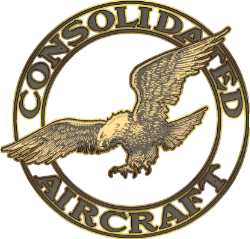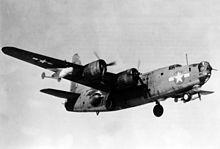Consolidated / Convair
PB4Y-2 Privateer
 |
|
| General information | |
|---|---|
| Type | Maritime patrol bomber |
| National origin | United States |
| Manufacturer | Consolidated Aircraft |
| Primary users | United States NavyUnited States Coast Guard |
| Number built | 739 |
| History | |
| Manufactured | 1943–1945 |
| Introduction date | 1943 |
| Retired | 1954, U.S. Navy1958, U.S. Coast Guard |
| Developed from | Consolidated B-24 Liberator |
.
History Consolidated / Convair
Consolidated PB4Y-2 Privateer
"Sea Liberator"
Manufactured 1943–1945, Introduction date 1943

The Consolidated PB4Y-2 Privateer is an American World War II and Korean War era patrol bomber of the United States Navy derived from the Consolidated B-24 Liberator. The Navy had been using B-24s with only minor modifications as the PB4Y-1 Liberator, and along with maritime patrol Liberators used by RAF Coastal Command this type of patrol plane was proven successful. A fully navalised design was desired, and Consolidated developed a dedicated long-range patrol bomber in 1943, designated PB4Y-2 Privateer.
The Consolidated PB4Y-2 Privateer is an American World War II and Korean War era patrol bomber of the United States Navy derived from the Consolidated B-24 Liberator. The Navy had been using B-24s with only minor modifications as the PB4Y-1 Liberator, and along with maritime patrol Liberators used by RAF Coastal Command this type of patrol plane was proven successful. A fully navalised design was desired, and Consolidated developed a dedicated long-range patrol bomber in 1943, designated PB4Y-2 Privateer. In 1951, the type was redesignated P4Y-2 Privateer. A further designation change occurred in September 1962, when the remaining Navy Privateers (all having previously been converted to drone configuration as P4Y-2K) were redesignated QP-4B.
Variants

The Privateer was externally similar to the Liberator, but the fuselage was longer to accommodate a flight engineer's station, and it had a tall single vertical stabilizer rather than the B-24's twin tail configuration. The Navy wanted a flight engineer crewmember to reduce pilot fatigue on long duration over water patrols. The single vertical tail was adopted from the USAAF's canceled B-24N design (and was slightly taller on the Privateer) because it would increase stability at low to medium altitudes for maritime patrol. The Ford Motor Company, which produced B-24s for the United States Army Air Forces, had earlier built an experimental variant (B-24K) using a single tail. Aircraft handling was improved. The single tail design was used on the B-32 Dominator and PB4Y-2 and was slated for the US Army Air Forces' proposed B-24N production model to be built by Ford, but that order (for several thousand bombers) was canceled on 31 May 1945.
0
KmCeiling
0
KmCombat RANGE
0
Km/hAircraft Speed
0
Max Crew
Photo Gallery
Consolidated / Convair / Vultee
Consolidated PB4Y-2 Privateer
"Sea Liberator"
Manufactured 1943–1945
Introduction date 1943


Consolidated Convair Vultee
Consolidated PB4Y-2 Privateer
General characteristics
- Crew: 11: two pilots, navigator, bombardier, five gunners, two radio operators
- Length: 74 ft 7 in (22.73 m)
- Wingspan: 110 ft 0 in (33.53 m)
- Height: 30 ft 1 in (9.17 m)
- Wing area: 1,048 sq ft (97.4 m2)
Powerplant
- Empty weight: (12,467 kg)
- Max takeoff weight: (29,500 kg)
- Powerplant: 4 × Pratt & Whitney R-1830-94 radial engines, 1,350 hp (1,007 kW) each
Specifications
- Maximum speed: 300 mph (482 km/h
- Cruise speed: 175 mph (282 km/h
- Range: 2,820 mi (4,540 km, 2,450 nmi)
- Service ceiling: 21,000 ft (6,400 m)
- Wing loading: 62 lb/sq ft (300 kg/m2)
Armament
- Guns: 12 × .50 in (12.7 mm) M2 Browning machine guns in six turrets
- Bombs: Up to 12,800 lb (5,800 kg) of bombs, mines, or torpedoes
Links to Youtube & Others
A limited number of refitted PB4Ys and P4Ys continued in civilian service as airtankers, dropping fire retardant on forest fires throughout the western United States.
Consolidated PB4Y-2 Privateer
The French Aéronavale was supplied with Privateers via the Mutual Defense Assistance Act, which they used as bombers during the Indochina War.
Youtube Link
The Navy eventually took delivery of 739 Privateers, the majority after the end of the war. Several PB4Y-2 squadrons saw operational service in the Pacific theater












